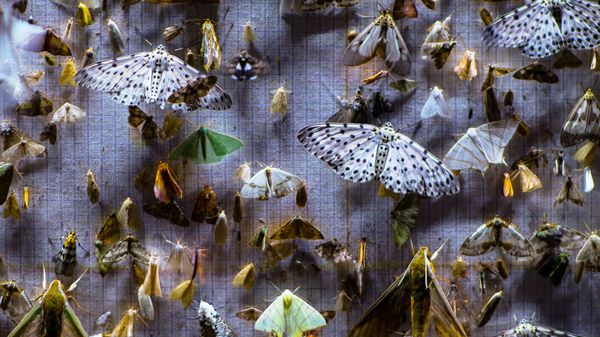Eye For Film >> Movies >> Nocturnes (2024) Film Review
Nocturnes
Reviewed by: Jennie Kermode

In the West, we don’t tend to pay a lot of attention to insects unless they annoy us, but we should. They make up 90% of all animal species, and they’re in trouble. In intensively farmed areas, their population has almost halved Across the world, the decline is thought to be somewhere between 10% and 40%. Moths are among the hardest hit. As this documentary points out, they have been around for some 300 million years, surviving five major extinction events – but will they survive this one?
One of the reasons why insects get so little attention is that they’re culturally disparaged: associated with disease (though relatively few species actually carry pathogens that can harm us) and thought of as ugly. On the latter point at least, this film will set you straight. From its opening scenes, in which we see hundreds of moths rush to assemble on a brightly lit white sheet at night, in invites viewers to marvel at the delicate beauty of these creatures, in all their variety. There are large ones whose wings are a deep velvety black, some with dark wings giving way to translucent sections, some white with black polka dots, some striped. There are soft-looking periwinkle blue ones, lemon yellow ones with iridescent patches, tiny emerald green ones. One specimen boasts a pattern of white, black, red and orange markings seen in Aztec art. Some have long, feathery antennae. Some have fluffy grey fur. Even Bicki, who is local to the area, gazes at them in awe. He has never seen them like this before.
Bicki – full name Gendan Marphew – has been recruited to help photograph the moths as part of a study. Mansi Mungee of Azim Premzi University has spent many years comparing the size of hawk moths at different elevations in the same patch of forest, tracking them across temperature gradients. She wants to know if, as the forest warms due to climate change, they will move up the mountain slopes or simply go extinct. This year there are few hawk moths around. She’s frustrated, trying to find suitable examples, but Bicki, who admits at the outset of the project that all moths look the same to him, is captivated by the process of discovery, as no doubt many viewers will be too. His curiosity and delight balance her worry and keep the film interesting from start to finish.
It is slow cinema. To study the moths is to study their environment, and directors Anirban Dutta and Anupama Srinivasan recognise the importance of immersing us within it. The study takes place in a great basin-like valley rimmed with cloud, full of birdsong by day. By night, Shreyank Nanjappa’s inspired sound design captures the furious beating of wings and, layered on top of them, the shuffling and chirrupping and all the curious calls of the moths as they rush in to land. There are beetles among them too, and the occasional grasshopper. We move in close as Bicki learns to identify tiny differences, then pull back, allowing us to be awed by their number. In the morning, everything is still: mist drifts through the old growth forest, all twisted, knotted branches and hanging vines, a rich drapery of verdure, as sleepy insects find shelter amongst the leaves.
In the lab, where photographs are compared and catalogued, we see specimen moths, dry and held in place by pins, kept in archives like old books. Each one is a treasure trove of information but, perhaps, when they can no longer be found alive, we will find that we don’t know how to read it. We do not know, Mungee observes, how many species have already disappeared. We watch a slender green caterpillar arching along a bough, searching for food, one tiny creature in this vast arena. How much of a future does it have?
This is difficult territory for researchers. We see them drive along precarious muddy roads, beside precipices; watch them hefting fallen rocks out of the way after a minor landslide. Elsewhere they squat in the cold, sharing stories. It is repeatedly said that there are elephants nearby, but we don’t see them until very late; they blend impressively well into the bush. For all their size, they leave no obvious trail of destruction. They are as much a part of this valley as the gnats that follow them, as the moths. All lives are intertwined here, all at risk from the rising heat. To those who find that insufficient to make them care, Dutta and Srinivasan appeal with imperilled beauty.
Reviewed on: 23 Oct 2024















